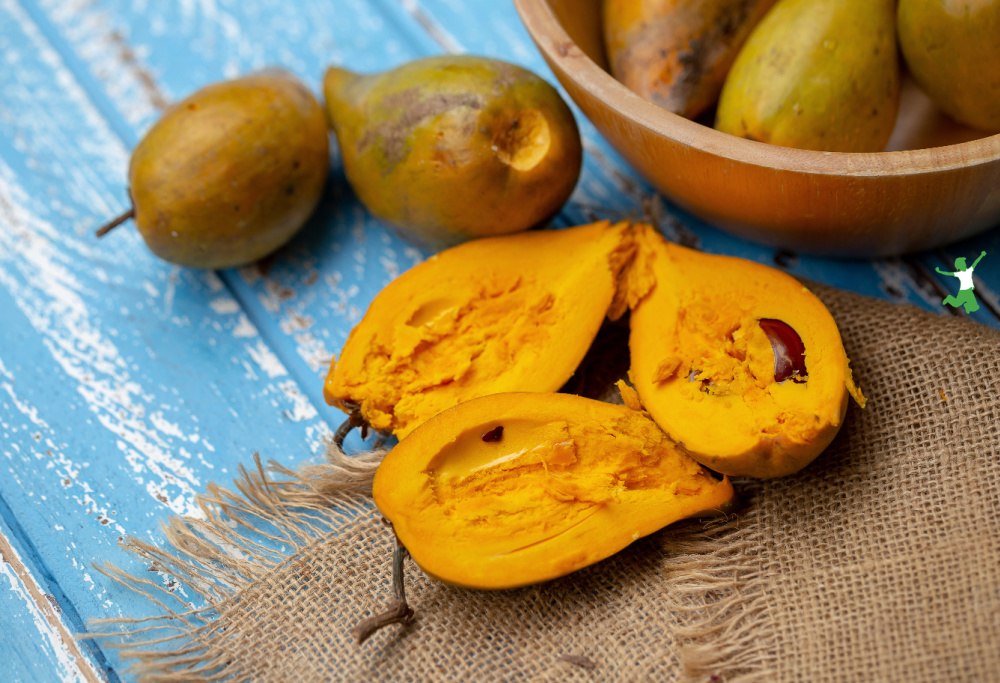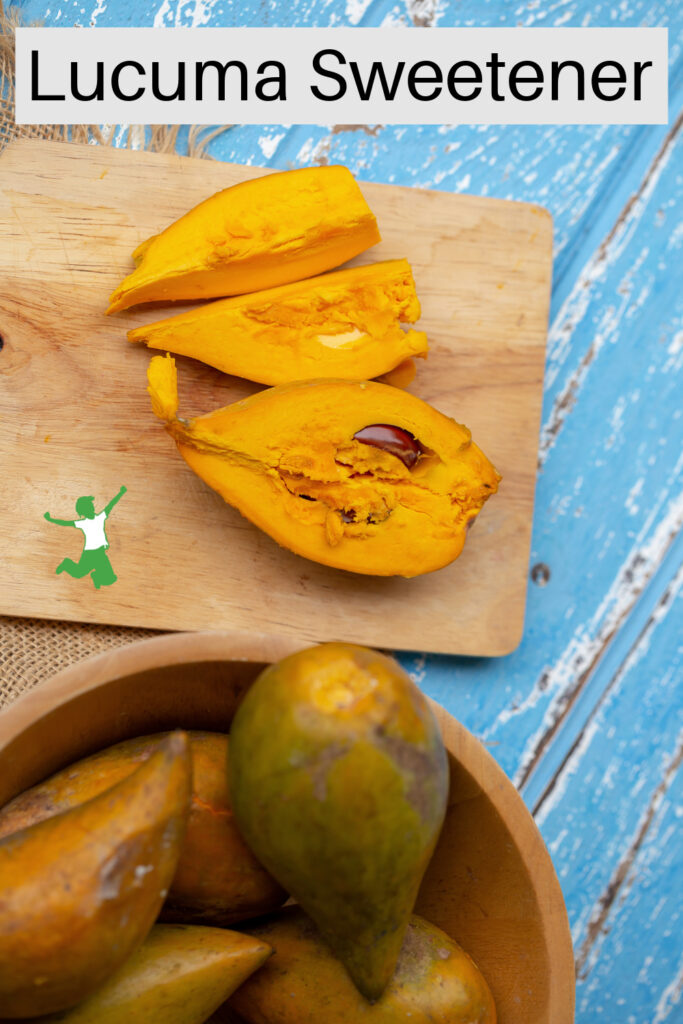Uses, benefits, and ideas for enjoying lucuma, a South American superfood fruit showing promise in powder form as an alternative sweetener.

The world offers so many amazing foods! The closer we get to the subtropics and tropics, the more these foods turn into fruits.
While bananas, mangoes, and papaya are some of the most common in America, an increasing number of exotic fruits are becoming more available on US grocery shelves – fresh, frozen, and even freeze-dried into powder.
Lucuma is one of the more recent additions that has gained attention as a superfood and a nutritious alternative sweetener!
What is Lucuma?
The lucuma fruit comes to us from the coastal mountain valleys of South America. In Peru, the word lucuma means “sun” because of the sun-colored flesh of the large, ripened fruit.
Personal take: Lucuma is perhaps the most delicious fruit I’ve ever tasted. I am growing three seedlings right now in the hopes that I can produce fruit-bearing trees of my own!
Lucuma trees, Pouteria lucuma, prefer higher elevations. You typically find them a half-mile (1000 meters) to a mile and a half or higher up in the valleys and slopes of the surrounding mountains.
The lucuma tree is quite hardy and able to endure freezing temperatures, dry soils, and adverse growing conditions.
This hardiness doesn’t result in a lack of productivity or size, however.
Some say that fully mature trees will often bear up to five hundred fruits per season weighing around two pounds each!
The trees will reach twenty-five to fifty feet in height, which is about two-thirds the height of an oak tree. (1)
Lucuma as a food has a long history of consumption and appreciation within native cultures in the area.
While it is often now called by outsiders the “Gold of the Incas,” we will see later on that this name points to a brewing problem not just with lucuma, but many traditional foods that gain attention from modern people.
Nutritional Value
If you come across a lucuma, it may remind you of a large avocado in terms of look and texture from the outside.
The firm outer shell hides a soft and delicious flesh inside. Similar to pastured eggs, when ripe, this flesh is sun-like in color.
While it may visually remind you of an avocado, the taste is similar to maple syrup and sweet potato. Others describe its flavor as caramel or a rich custard.
This sweetness doesn’t translate into high levels of sugar, however.
The fruit is actually quite low on the glycemic index, coming in at just 25. Thus, it is considered a diabetic-friendly fruit option. (2)
Like many foods grown in the Andes region, lands well-known for their rich mineral content, the lucuma doesn’t disappoint.
The lucuma is high in potassium, calcium, magnesium, and phosphorus.
The fruit’s flesh is a starchy food, over 80% carbohydrate, with just a small amount of protein and fat. It also contains a wide array of trace minerals in small amounts.
However, the inedible nut is high in beneficial fatty acids. Leading researchers are studying these for medical use. More on this below.
Regarding vitamins, you may have guessed that lucuma is a good source of carotenes (precursors to vitamin A) due to its vibrant, sunny color.
It also contains various B vitamins, including B3 (niacin) and many other phytonutrients.
In fact, lucuma can contain so much niacin that some people eating it for the first time may temporarily experience the pleasant glow of a detoxifying niacin flush.
A similar experience happens to some people drinking kombucha tea for the first time.
Scientific Research
A number of interesting studies have examined the benefits of different parts of the lucuma fruit.
Rutgers University tested lucuma oil and its possible benefits for skin wounds and aging.
Scientists concluded that the fatty acids from the hard inner seed significantly increased wound closure and promoted tissue regeneration.
Lucuma nut oil may have anti-inflammatory, anti-aging, and skin-repair effects on human skin as well.
The results of this study drove Rutgers University to apply for a patent on lucuma extracts, particularly the oil. (3)
Other studies on the consumption of the fruit itself point to benefits for normalization of blood pressure and insulin levels.
The Journal of Medicinal Food published that lucuma displayed potent angiotensin-converting enzyme (ACE) inhibitory activities (relaxation of blood vessels) in a test tube environment (in vitro).
This could translate into possibly decreasing the effects associated with hypertension.
This same journal also published that lucuma consumption may also support normal blood sugar levels.
Current research points to possible benefits of additional nutritional support for those with type II diabetes. (4)
Health Benefits
Lucuma didn’t get its name merely because of its color.
For generations, the Incan people prized this food for improving fertility. Once the New World explorers came across it, other uses became common.
According to texts from the 1800s, Europeans used the latex from the immature fruit to treat skin problems such as warts and wounds.
Extracts of the hard inner seed treat stomach, bladder, and other urinary tract issues. (5)
Unfortunately, these benefits are now at the center of an international patent battle similar to what is happening between New Zealand and Australia concerning manuka honey.
Rutgers is seeking to gain control over lucuma oil and its use in pharmaceuticals, cosmetics, and any other applications to the skin. (6)
As you might imagine, Peru and other South American countries are not too thrilled about a US university, supported by a large investment corporation, trying to take over and control the rights to their native superfood and its traditional uses!
How to Consume Lucuma
As you can see, lucuma as both food and medicine has a rich history.
Like avocados, it makes a great stand-alone snack if you can get your hands on it fresh.
Again, I highly encourage you to try and locate it fresh at farmer’s markets if you live in temperate climes. The time spent searching is well worth it.
I just picked up a case of lucuma at an ethnic local market. It was a rare find even here in Central Florida. What we don’t eat fresh in 1-2 weeks, I will freeze to enjoy for many months, or maybe dry into a powder.
One of the favorite ways the Peruvian people enjoy this fabulous fruit is as lucuma ice cream made from the fresh fruit in season or the dried pulp year-round.
Alternative Sweetener?
As I mentioned earlier, it is difficult to find lucuma in the United States. The fruit ripens very quickly and is too delicate for long-distance shipping.
Some growers in California and Hawaii are attempting to grow it for domestic use, but so far if you want to try lucuma, your best bet is to look for local growers.
Second best is lucuma powder that is widely available online and in some healthfood stores. I recommend this brand.
Lucuma fruit or powder makes a tasty addition to smoothies and similar dishes and drinks.
Another common use of the powder is as a sugar or similar sweetener substitute in tea, coffee, yerba mate, and other beverages.
Like monk fruit, lucuma powder is a nutritious sweetening alternative for diabetics. Lucuma powder has a FAR better taste though! It is also a more budget-friendly option (pure monk fruit is quite pricey).
Certainly, lucuma powder is a much preferred option to artificial concoctions like allulose, acesulfame potassium, and sucralose!
It is also a better option to gut-disrupting sugar alcohols such as Swerve or xylitol.
How Much to Use
A serving of lucuma powder is two teaspoons. This amount contains 20 calories, no protein, no fat, and 4 grams of carbs (plus 2 g of fiber).
Nutritionally, lucuma powder offers 47 milligrams of potassium and 4 milligrams of calcium per serving.
Generally speaking, you only need about a teaspoon to add to a cup of tea or coffee to sweeten it.
Use the full 2 teaspoons for smoothie recipes.
Fresh or Frozen
A few places may occasionally carry frozen lucuma, similar to other chunk frozen fruits, or as a pulp.
If you are in the southern US (especially Florida) and perhaps California, you may find it in Latin-American or similar ethnic grocery stores.
I found my precious case of lucuma (a dozen and a half) at a Hispanic market.
It is really fun and educational to take a look around stores and ethnic markets you may not typically frequent to see what amazing superfoods you can find seasonally!

(1) Lucuma Fruit
(2) Glycemic Index
(3) Wound-healing properties of nut oil from Pouteria lucuma
(4) Evaluation of antihyperglycemic and antihypertension potential of native Peruvian fruits using in vitro models
(5) It’s Time to Add Lucuma Powder to Your Grocery List
(6) US Researchers File Patent on the Lucuma Fruit, a Flagship Product of Peru








Sadly, it’s not keto but yacon syrup is. I’m keto cause I’m allergic to grains and most starches.
The product description says it is at least 95% of organic material. What is the other 5%?
The link is broken for the brand that you recommend. Would you mind relinking or giving the name of the brand that you like? Appreciate it!
Thanks for the heads up. Here’s the fixed link (also in post). https://amzn.to/4gH8yaB
I like to use lucuma (the same brand) in some baking, like muffins. Do you know if it retains it’s nutritional value through the cooking/baking process? Thanks!
Some nutrients are destroyed. But, by and large, it does retain its nutrients quite well when cooked or baked!
I have had some in the cupboard for a couple of years or more. Any ideas on if it is still safe to eat?
Should be fine if the bag was sealed.